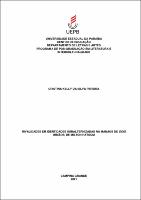| Compartilhamento |


|
Use este identificador para citar ou linkar para este item:
http://tede.bc.uepb.edu.br/jspui/handle/tede/3726Registro completo de metadados
| Campo DC | Valor | Idioma |
|---|---|---|
| dc.creator | Pereira, Cristina Kelly da Silva | - |
| dc.contributor.advisor1 | Magalhães, Antonio Carlos de Melo | - |
| dc.date.accessioned | 2021-05-13T01:10:46Z | - |
| dc.date.issued | 2021-02-26 | - |
| dc.identifier.citation | PEREIRA, C. K. da S. Rivalidade em identidades subalternizadas na Manaus de dois irmãos, de Milton Hatoum. 2021. 169 f. Tese (Programa de Pós-Graduação em Literatura e Interculturalidade - PPGLI). - Universidade Estadual da Paraíba, Campina Grande, 2021. | por |
| dc.identifier.uri | http://tede.bc.uepb.edu.br/jspui/handle/tede/3726 | - |
| dc.description.resumo | O presente trabalho de doutoramento em Literatura e Interculturalidade consistiu em analisar a obra Dois irmãos (2000), do escritor manauara Milton Hatoum. Para tanto, objetivou-se propor uma chave de leitura que evidencia três elementos temáticos: cidade, rivalidade e identidades subalternizadas. Dois irmãos se constitui numa prosa contemporânea que possui a singularidade de transformar a cidade de Manaus em personagem literário. Milton Hatoum, com seu olhar atento, capta usos e costumes da sociedade amazonense e, na mistura de ficção e realidade, opta por uma narrativa clássica, mas, escolhe como vozes enunciadoras, personagens subalternizados, como a empregada doméstica indígena, Domingas, e seu filho bastardo, Nael, o narrador do romance. A temática da rivalidade, fortemente intrafamiliar, além de central e transversal, não se encerra no contexto privado da família, dado que dela emergem outras rivalidades que se cruzam, envolvendo uma gama de distintas faces: política, econômica, social, religiosa, urbanística, cultural, etc. A tese em tela partiu dos Estudos Culturais para problematizar as representações sociais presentes na obra, com a preocupação em analisar o texto como um produto da cultura capaz de produzir significado e sentido. Para debater a temática da rivalidade na perspectiva da violência e do desejo, lançamos mão da teoria do desejo mimético (GIRARD); para discutir sobre as múltiplas rivalidades presentes na obra da perspectiva das vozes subalternas, utilizamos o conceito de subalternidade (SPIVAK); para situar o lugar epistemológico da produção latino-americana, o conceito de balbuciar (ACHUGAR); por fim, para jogar luz sobre o sujeito ordinário, insubmisso, que produz bricolagens como forma de táticas para sobreviver às imposições dominantes, utilizamos as contribuições do conceito de táticas e estratégias na invenção do cotidiano (CERTEAU). | por |
| dc.description.abstract | The present doctoral work in Literature and Interculturality, consists of proposing a reading key for the appreciation of the work Dois Irmãos (2000), by the manauara writer Milton Hatoum, from the thematic approach of the city, rivalry and subalternized identities. A contemporary, has the singularity of transforming the city of Manaus into a literary character. Milton Hatoum, with his watchful eye, captures the uses and customs of Amazonian society and, in the mixture of fiction and reality, opts for a classic narrative, but chooses as enunciating voices, subalternated characters, such as the indigenous maid, Domingas, and his bastard son, Nael, the narrator of the novel. The theme of rivalry, strongly within the family, in addition to being central and transversal, does not end in the private context of the family, given that other rivalries emerge from it, involving a range of different faces: political, economic, social, religious, urbanistic, cultural, etc. The study on screen starts from Cultural Studies to problematize the social representations present in the work, with the concern to analyze the text as a product of culture capable of producing meaning and sense. To debate the theme of rivalry from the perspective of violence and desire, we will use the theory of mimetic desire (GIRARD); To discuss the multiple rivalries present in the work from the perspective of subaltern voices, we used the concepts of subalternity (SPIVAK); to situate the epistemological place of Latin American production, the concept of babbling (ACHUGAR); finally, to shed light on the ordinary individual, an unsubmissive that produces bricolage as a form of tactics to survive the impositions dominant, we use the contributions of the concept of invention of the daily life (CERTEAU). | eng |
| dc.description.provenance | Submitted by Alberto César do Nascimento Silva (allbertocns@gmail.com) on 2021-04-29T14:23:34Z No. of bitstreams: 1 TESE - CRISTINA KELLY DA SILVA PEREIRA.pdf: 1738122 bytes, checksum: 47fa40122575e3a1bde91efec534bc7f (MD5) | eng |
| dc.description.provenance | Approved for entry into archive by João Costa (joaocosta@uepb.edu.br) on 2021-05-13T01:10:46Z (GMT) No. of bitstreams: 1 TESE - CRISTINA KELLY DA SILVA PEREIRA.pdf: 1738122 bytes, checksum: 47fa40122575e3a1bde91efec534bc7f (MD5) | eng |
| dc.description.provenance | Made available in DSpace on 2021-05-13T01:10:46Z (GMT). No. of bitstreams: 1 TESE - CRISTINA KELLY DA SILVA PEREIRA.pdf: 1738122 bytes, checksum: 47fa40122575e3a1bde91efec534bc7f (MD5) Previous issue date: 2021-02-26 | eng |
| dc.format | application/pdf | * |
| dc.thumbnail.url | http://tede.bc.uepb.edu.br/jspui/retrieve/9885/TESE%20-%20CRISTINA%20KELLY%20DA%20SILVA%20PEREIRA.pdf.jpg | * |
| dc.language | por | por |
| dc.publisher | Universidade Estadual da Paraíba | por |
| dc.publisher.department | Centro de Educação - CEDUC | por |
| dc.publisher.country | Brasil | por |
| dc.publisher.initials | UEPB | por |
| dc.publisher.program | Programa de Pós-Graduação em Literatura e Interculturalidade - PPGLI | por |
| dc.rights | Acesso Aberto | por |
| dc.subject | Análise literária | por |
| dc.subject | Manaus - Amazonas | por |
| dc.subject | Rivalidade | por |
| dc.subject | Subalternidade | por |
| dc.subject.cnpq | LINGUISTICA, LETRAS E ARTES::LETRAS | por |
| dc.title | Rivalidade em identidades subalternizadas na Manaus de dois irmãos, de Milton Hatoum | por |
| dc.type | Tese | por |
| Aparece nas coleções: | PPGLI - Teses | |
Arquivos associados a este item:
| Arquivo | Descrição | Tamanho | Formato | |
|---|---|---|---|---|
| TESE - CRISTINA KELLY DA SILVA PEREIRA.pdf | 1.7 MB | Adobe PDF |  Baixar/Abrir Pré-Visualizar |
Os itens no repositório estão protegidos por copyright, com todos os direitos reservados, salvo quando é indicado o contrário.




